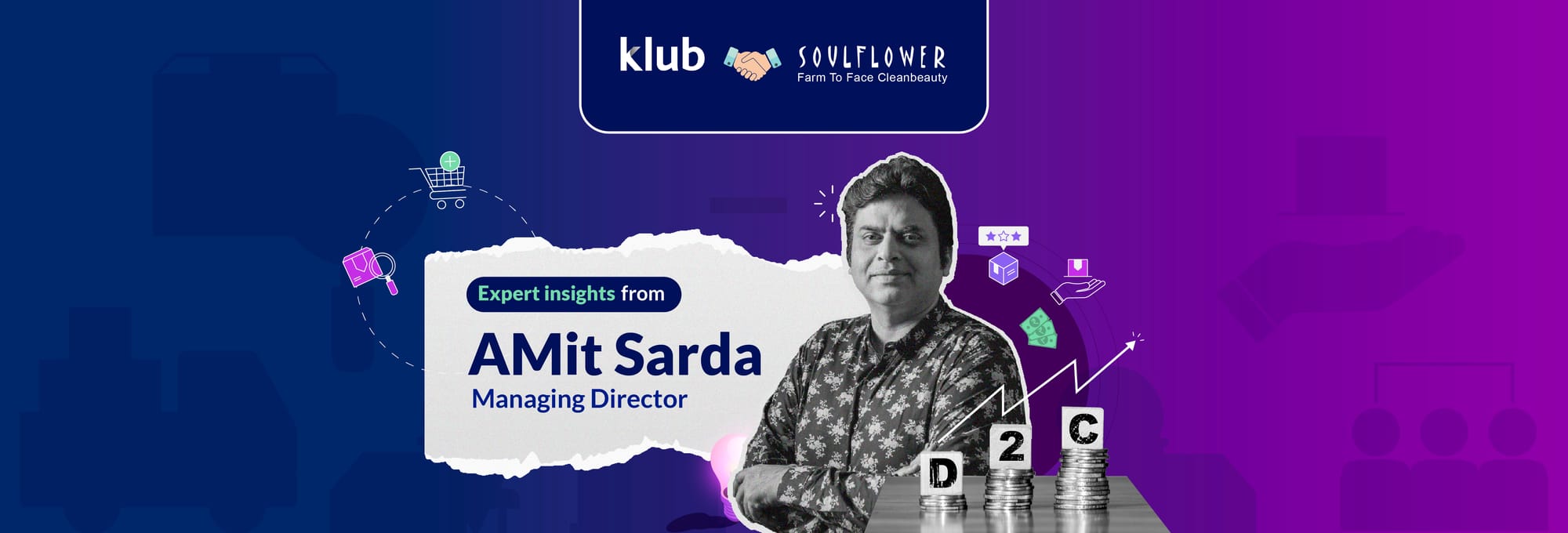
How to successfully grow your personal care brand in India: Expert tips from Soulflower
Thu Feb 15 2024
6 min read
As the founder of a D2C personal care business, you've likely encountered numerous challenges in differentiating and expanding your brand in a market crowded with established FMCG giants and emerging D2C companies.
The challenges span a broad spectrum, encompassing decisions on which demographic to target, the strategic choice between selling on one or multiple ecommerce marketplaces, the timing for venturing into offline retail, gauging the right metrics and navigating the complexities of scaling.
These are just a few of the pivotal challenges at hand.
We contacted AMit Sarda, Managing Director at Soulflower, a premium, organic skin & hair care brand, to uncover the answers to these lurching questions.
Whether you are just starting out or have been in business for a while, these tips will help you take your brand to the next level.
1. Understanding consumer behaviour
Challenge: How do I target and focus the right demographic through data analytics?
When targeting a specific demographic, gathering data and insights that help you understand their needs, behaviours, and preferences is crucial to adjust your marketing strategies to reach and engage with them effectively.
Solution: When targeting the right demographic, AMit emphasises the importance of understanding your customer's behaviour.
Through thorough data analysis of your own and, if possible, your competitors, you can unveil key insights such as
- The age group of your customers,
- Geographical locations (Tier-1, Tier-2, Tier-3 cities),
- Preferred mobile phone brands (iPhones or Android),
- Channel buying preferences,
- Payment channels, and more.

2. Strategic choice between D2C and marketplace selling
Challenge: Should I stick to D2C selling or sell on marketplaces as well?
While D2C selling offers numerous advantages, it's essential to recognise that alternative avenues exist for business expansion.
It's unwise to challenge your target demographic's established buying behaviours (whether they like to buy from D2C, online marketplaces, or offline retail stores).
Solution: A pivotal insight shared by Soulflower's MD underscores the importance of aligning your sales channels with the preferences of your target audience.
Adapt your selling strategy to meet their preferences. If your customers demonstrate a preference for purchasing from prominent marketplaces like Nykaa and Amazon, it's imperative to establish a presence on these platforms.
Understanding the nuanced buying channel behaviours of your customer base is paramount. For example, individuals residing in Tier-2 and Tier-3 cities may exhibit a reluctance to trust D2C websites for purchases. Instead, they gravitate towards established marketplaces such as Nykaa, Amazon, Flipkart, or multi-brand retail stores.

3. Strategic choice between targeting one or multiple ecommerce marketplaces
Challenge: Wouldn’t it be advantageous to sell on all the ecommerce platforms?
When it comes to choosing between selling on one or multiple ecommerce marketplaces, meticulous market research is imperative.
Solution: AMit recommends beginning by thoroughly analysing your competitors and gaining a deep understanding of your customer's journey. Identify which platforms drive your competitors' sales because the same platform also has your target customers.
Before launching your products on any e-commerce platform, it's crucial to identify the most suitable marketplaces for your business. Start by selecting a primary marketplace, often called the "hero marketplace," such as Amazon or Flipkart. Focus on establishing a robust presence and driving sales on this one platform.

4. Tactics for boosting sales on Amazon and Nykaa
Challenge: How do I boost my sales on Amazon, Flipkart & Nykaa?
With so many products on these platforms, standing out and attracting customers can be challenging. Furthermore, many factors, such as product pricing, listing optimisation, advertising, and customer reviews, can influence sales.
Solution: Regarding tactics for boosting sales on Amazon, AMit suggests focusing on a few products from a range of products in your portfolio. This strategic approach increases your likelihood of success and enhances visibility on Amazon.
AMit shares that a key metric to prioritise on Amazon is the number of glance views your products receive. Glance views occur when a customer spends more than 10 seconds on your product page.
As your product page attracts more glance views, it sends a strong signal to both Amazon and Google algorithms that potential customers are highly engaged with your product, which, in turn, significantly improves your product's visibility.
Moreover, to enhance your product's visibility on Amazon, it's essential to meet three critical criteria:
- Maintaining a sufficient inventory level
- Ensure swift delivery speed
- Achieving higher conversion rates
Fulfilling all three criteria increases the likelihood of your product ranking at the top of Amazon's listings.

AMit underscores that Soulflower excels in all three categories, contributing to its success on the platform.
AMit also shares how they succeeded on Nykaa and tripled their revenues.
“The reason we chose Nykaa as our distribution channel is because, with Nykaa, we could tap into an already educated customer base in the Beauty & Personal Care category. They already knew the benefits of rosemary oil and hair serums for growth, therefore minimising our efforts to educate customers.
Initially, our customers were unaware that we were present on Nykaa, but as we began to spread the word, our customer base on the platform grew significantly.
Our approach involved understanding customers' purchasing behaviour and demographics through data analytics. We discovered that 32% of our customers belonged to Tier-3 cities, a significant proportion compared to the average percentage of Tier-3 customers for any brand on Nykaa (10-12%). We also realised that marketing our products to our target audience and diverting our traffic to Nykaa was a more effective strategy than relying solely on D2C selling.
We persuaded our customers to buy from Nykaa through discounts, so our conversion rates on the platform increased to 25-28%. The Nykaa algorithm then began promoting our products to more people, and we began to top search results on Nykaa.”
5. Considerations regarding the utilisation of performance marketing
Challenge: Can I just rely on performance marketing alone to drive sales?
Solution: While running search/display ads on platforms like Google and various ecommerce and quick commerce platforms is crucial for maintaining visibility and driving sales, prioritising brand building is paramount.
AMit feels performance marketing can be excellent in increasing the top-of-the-funnel leads, but beware of relying solely on it for long-term sustainability.
Your branding game will help you sail through the challenges of scaling your brand and nurturing it for long-term success. Gradually, your sales/ROI should keep increasing, and your performance marketing budget should keep diminishing or at least come to a sustainable level.

6. Crafting a compelling branding strategy
Challenge: What are some effective strategies for building a strong brand?
Solution: AMit stresses the importance of content-driven strategies on social media and enhancing SEO efforts to establish a strong brand presence. Ensuring your product pages rank well on platforms like Google and Amazon for relevant category keywords is vital.
Quality content creation plays a central role in building brand equity for new-age companies, with two key pillars identified:
- Social media engagement: Engage with your target audience across various platforms, sharing informative content to educate and connect with them effectively. Soulflower has a reach of 5 Cr unique accounts on a monthly level on Instagram.
- SEO optimisation: Optimise your website and product pages for search engines to improve visibility and attract organic traffic.

7. The right timing for venturing into offline retail
Challenge: When is it appropriate to expand an online store to offline markets?
Offline is tough terrain to navigate, especially if you have experience and resources of only selling through D2C websites and/or marketplaces.

Finally, creating value and tracking the right KPIs
The fundamental strategy for business success is creating value for customers and stakeholders. This entails smart allocation of resources - be it finances, manpower, time, or effort - ensuring optimal outcomes. While tools and techniques are helpful, prudent resource allocation is paramount for sustainable growth.
After establishing a high-quality product, prioritise marketing and brand-building efforts.
Tracking key performance indicators (KPIs) relevant to your business is essential rather than blindly following industry norms. Remember that what works for one company may not necessarily work for another. Hence, discovering and refining strategies tailored to your unique needs is crucial for long-term success.








